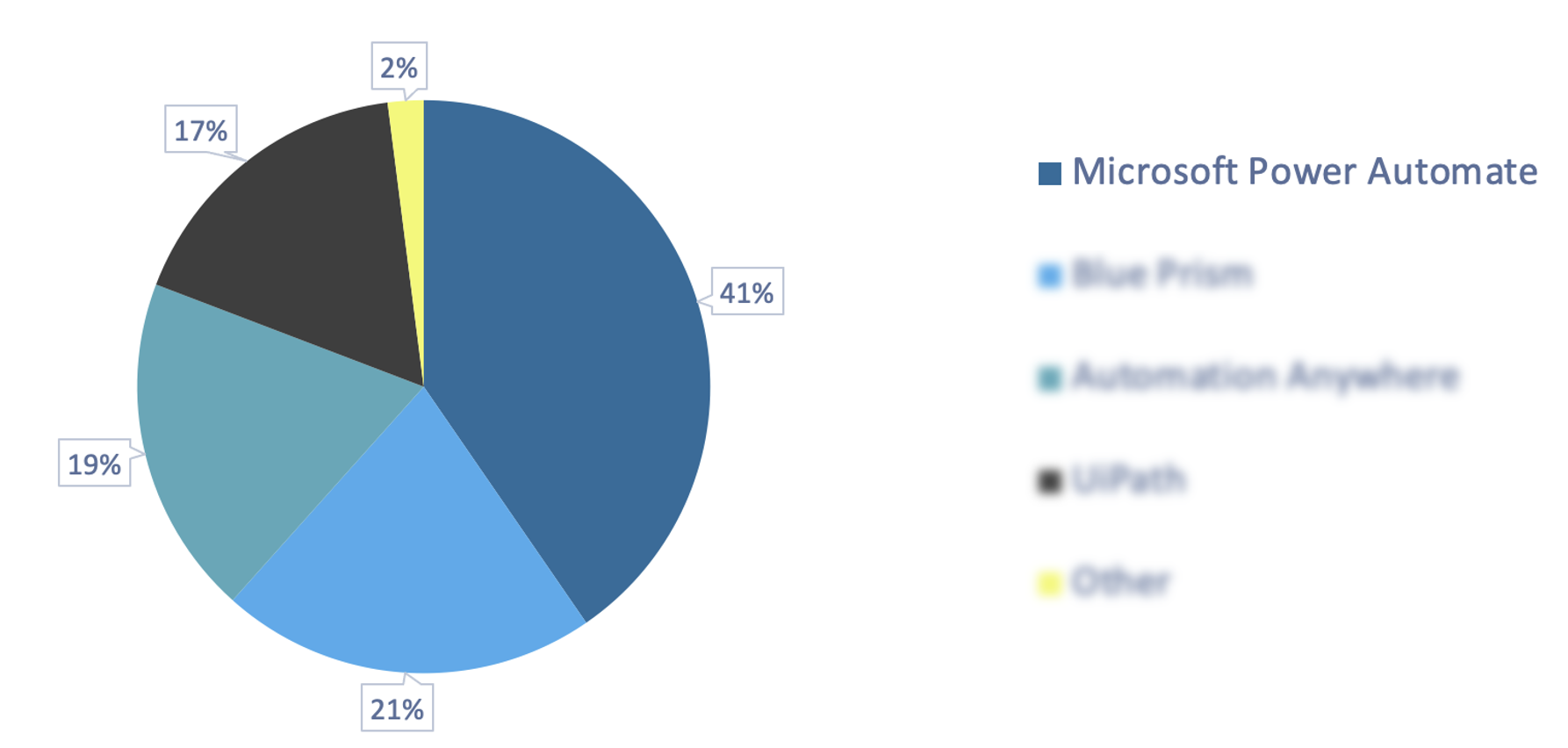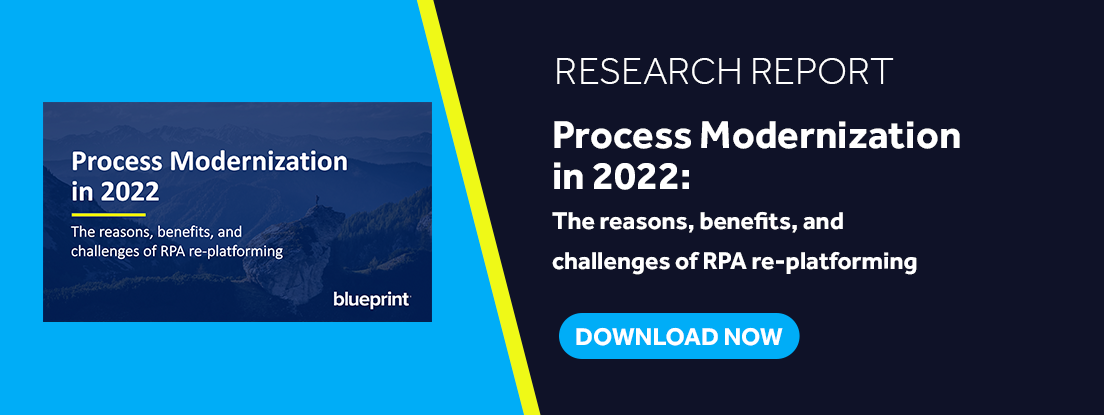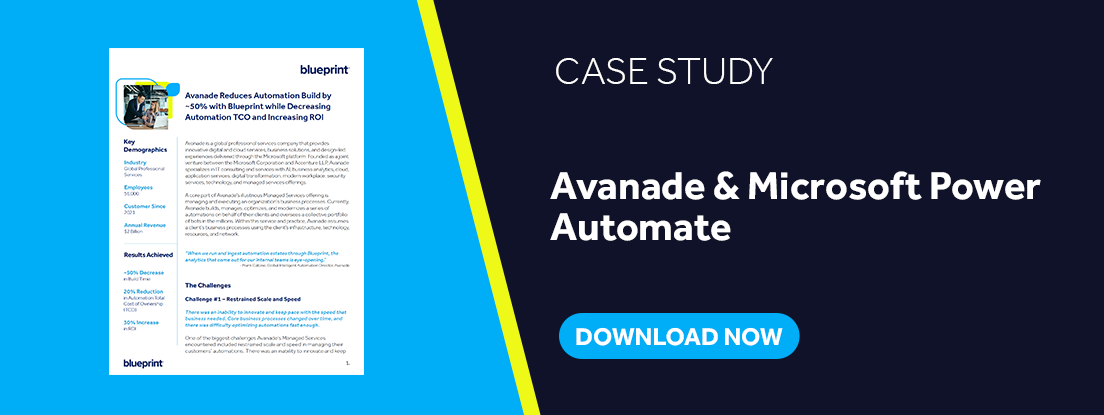The 4 Benefits of Switching to Microsoft Power Automate
Gartner recently released the 2022 edition of its Magic Quadrant for Robotic Process Automation (RPA). Unsurprisingly, Microsoft gained even more ground in the leader category.
Why wasn’t it a surprise? Because it’s Microsoft. Even though they’re relatively new in the automation space, whenever Microsoft decides to enter an enterprise software category, it’s just a matter of time before they’re a leader, if not sitting alone at the top of their market with their competitors in their review mirror.
Microsoft’s automation offering – Power Automate – is no different and has many benefits. In a recent study Blueprint performed on automation migration to new RPA solutions, of the respondents considering switching RPA platforms, the most likely destination was Microsoft Power Automate.

Download the report here to see all the insight Blueprint collected on RPA migration and re-platforming
These are the reasons why so many organizations interested in migrating their automation estates to a new RPA platform are choosing Microsoft Power Automate and the benefits they can expect.
The 4 Benefits Driving Organizations to Switch to Microsoft Power Automate
#1 Lower Total Cost of Ownership for Automation
According to Blueprint’s research on RPA platform migration, lowering the total cost of ownership is one of the most frequently given reasons organizations are looking to switch automation providers.
In that regard, Microsoft Power Automate offers one of the most competitive price points available in the automation market. A free version of the software was included in both Windows 10 and 11. However, there was a cost associated with running and scheduling any automations. In addition, most organizations already use Microsoft 365, and Power Automate can easily be bundled into existing contracts at a reduced cost.
This is strictly from a licensing and cost perspective. In a recent case study Blueprint completed with Avanade - a major system integrator that Blueprint partners with - they were able to lower the total cost of ownership by 27% for their clients when switching them to Microsoft Power Automate.
#2 Compatibility with all Microsoft suite of products
Simply put, Microsoft Power Automate enables organizations to automate more business processes and tasks because of its compatibility with all Microsoft products. For example, Power Automate can open Microsoft Excel with one click instead of having to code 10 actions in another RPA tool when designing an automated process.
Power Automate slides in seamlessly into any enterprise architecture where there is already a myriad of Microsoft products in use, so developing and delivering automations is significantly more cohesive, easier, and importantly, can be accomplished quickly. Avanade, for example, can cut the deployment time of automations by 30% when running automation estates on Microsoft Power Automate.
#3 Easier to design and deliver automations
From a UX perspective, Power Automate delivers a much more accessible point of entry to automation for all business users. Microsoft’s automation solution has the same look and feel of all Microsoft products, so there’s a familiarity there to help orient all types of users looking to design automated processes.
Power Automate also offers a drag and drop canvas to democratize automation further and enable scale by opening up intelligent automation to more than just RPA developers and highly skilled technical resources.
#4 Increase in ROI
With a lower total cost of ownership and simplified and accelerated time to delivery, what naturally follows is a dramatic increase in returns and ROI from your automation investment when switching to Microsoft Power Automate.
In Avanade’s case and the automation estates they manage, they increased ROI by 30% for one customer after they used Blueprint to help them transition to Microsoft Power Automate. Even though re-platforming automation portfolios is no easy feat, Avanade can accelerate the process while dramatically reducing costs because they use Blueprint’s automation migration solution. Frank Catone, Global Intelligent Automation Director at Avanade, explains,
“When migrating automation estates, there are a few pieces to the process: design, build, test, and deploy. The analytics Blueprint provides allowed us to take out 40-60% of our build cycles, but with Blueprint’s analytics, we’re also able to accelerate and improve design, testing, and deployment.”
For all the details on how Blueprint enables accelerated and cost-effective migrations to Microsoft Power Automate and how Avanade can optimize automation estates and increase returns in Power Automate, read the full case study here.
Share this
Recent Stories

Part 2 - The Challenges of Switching to Microsoft Power Automate Manually



